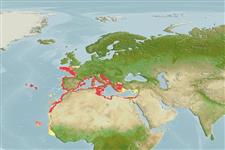Common names from other countries
Environment: milieu / climate zone / depth range / distribution range
Ecología
; rango de profundidad 0 - 200 m (Ref. 2754). Subtropical, preferred 19°C (Ref. 107945); 50°N - 9°N, 32°W - 36°E (Ref. 99669)
Eastern Atlantic and the Mediterranean: North to the Channel Islands, south to Guinea, including Azores, Canary and Cape Verde Islands, and east to the Mediterranean. Introduced in Ireland and Gulf of Aqaba, Red Sea in Israel.
Length at first maturity / Tamaño / Peso / Age
Maturity: Lm 4.9, range 4 - 5.4 cm Max length : 12.3 cm SHL macho / no sexado; (Ref. 99669); common length : 8.0 cm SHL macho / no sexado; (Ref. 438); edad máxima reportada: 15 años (Ref. 99669)
Collected from the sublittoral zone, from low tide up to a depth of 200 m (Ref. 2754).
Life cycle and mating behavior
Madurez | Reproducción | Puesta | Huevos | Fecundidad | Larva
Gonochoric; broadcast spawners (males release first before the females). Spawning occurs from spring to late autumn.
Demir, M. 2003. (Ref. 2754)
IUCN Red List Status (Ref. 130435: Version 2024-1)
CITES status (Ref. 108899)
Not Evaluated
Not Evaluated
Human uses
Pesquerías: comercial
FAO - Acuicultura: producción; pesquerías: landings | FishSource | Sea Around Us
Herramientas
Fuentes de Internet
Estimates based on models
Preferred temperature
(Ref.
115969): 7 - 18.6, mean 10.5 (based on 572 cells).
Resiliencia
Alto, población duplicada en un tiempo mínimo inferior a 15 meses (K=0.27-0.4; tm=3; tmax=15).
Vulnerability
Moderate vulnerability (39 of 100).
